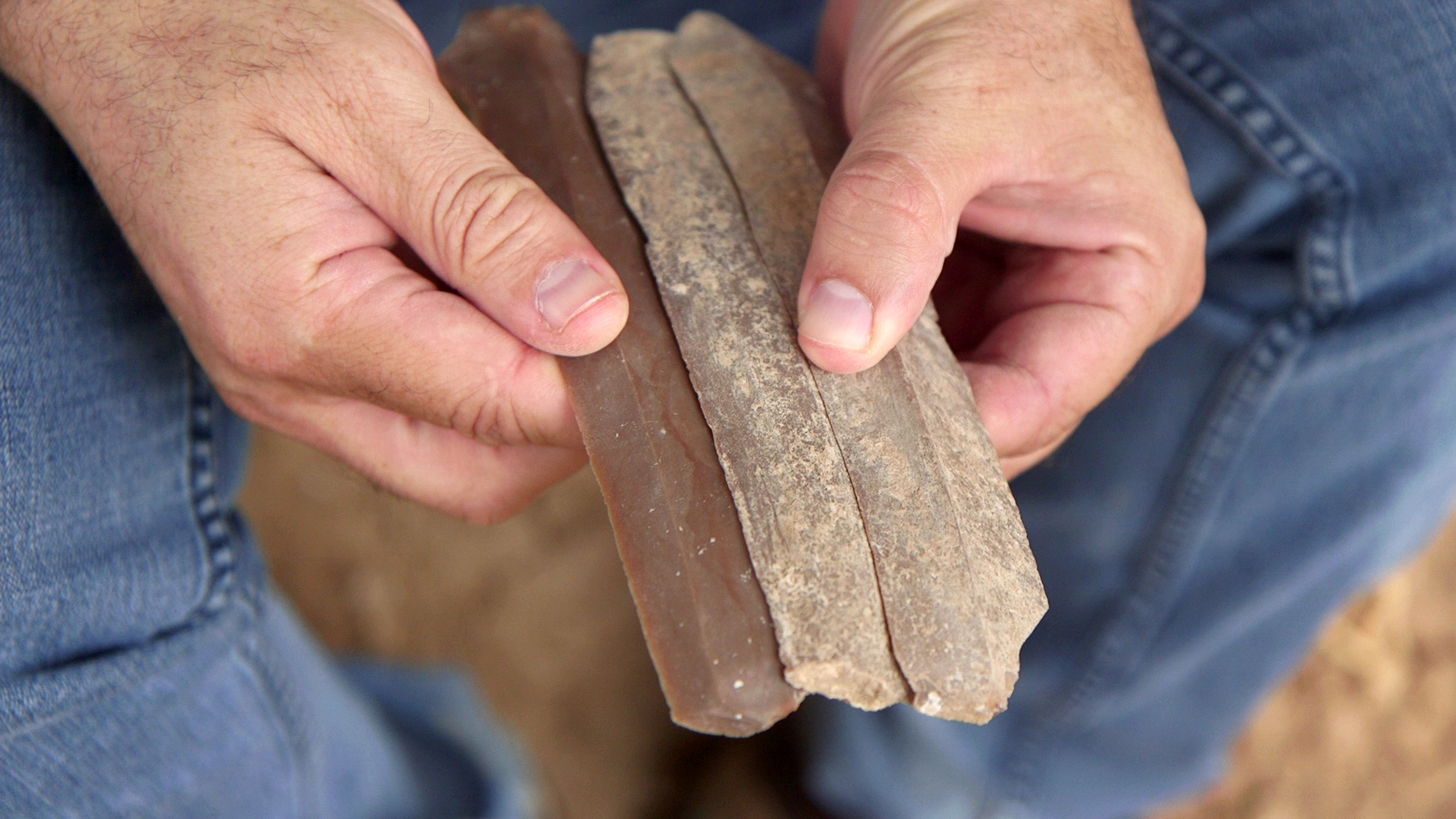In a remarkable archaeological breakthrough that bridges millennia of human technological achievement, researchers from the Israel Antiquities Authority have uncovered the first-ever flint blade manufacturing workshop discovered in southern Israel. The 5,500-year-old site, excavated near Kiryat Gat in preparation for the new Carmei Gat neighborhood, represents a pivotal moment in understanding the sophisticated technological capabilities of Early Bronze Age societies in the ancient Levant.
The discovery at the Naḥal Qomem site (also known as Gat-Govrin or Zeita) has yielded unprecedented insights into what archaeologists are calling the “Canaanite blade industry” – a specialized craft that required extraordinary skill and represents clear evidence of professional specialization and complex social structures at the dawn of urbanization in the Land of Israel.
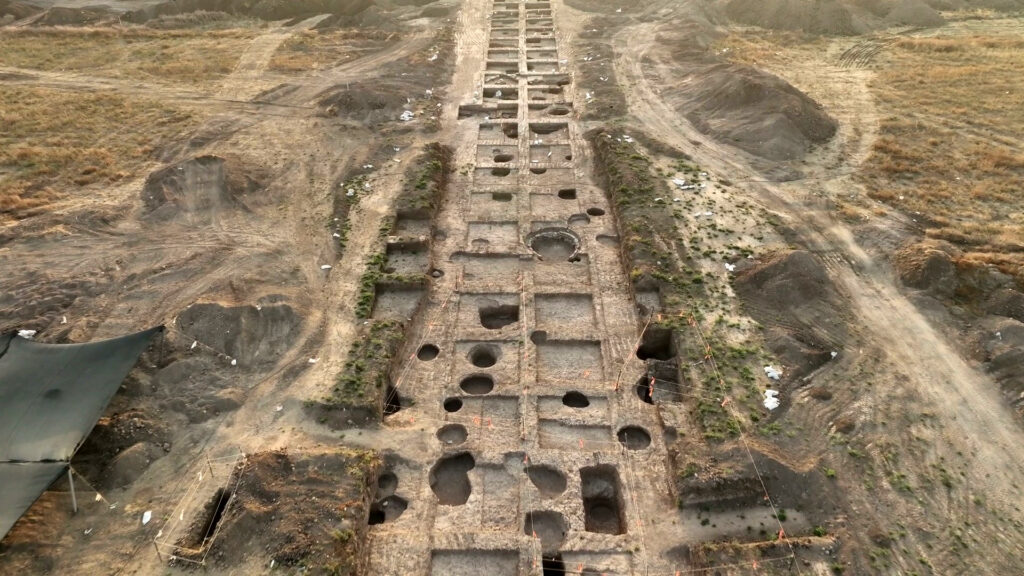
The Israel Antiquities Authority excavation near Kiryat Gat. Photography: Emil Aladjem, Israel Antiquities Authority.
According to Dr. Martin David Pasternak, Shira Lifshitz, and Dr. Nathan Ben-Ari, the excavation directors, this discovery fundamentally challenges previous assumptions about technological sophistication in the Early Bronze Age. “This is the first time such a workshop has been discovered in southern Israel,” they explain. “Although evidence of the Canaanite blade industry has been discovered in the country’s center and north, there are almost no known workshops for their systematic production.”
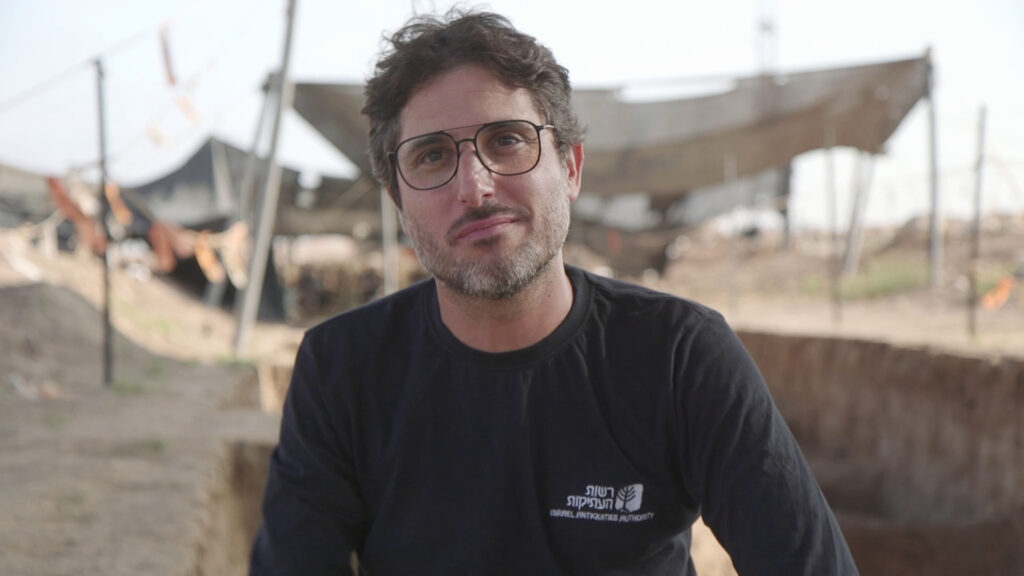
Dr. Martin-David Pasternak, Excavation Director on behalf of the Israel Antiquities Authority, with the new findings. Photography: Emil Aladjem, Israel Antiquities Authority.
The workshop reveals an advanced manufacturing process that requires exceptional expertise. Israel Antiquities Authority prehistorians Dr. Jacob Vardi and Dudu Biton emphasize the remarkable skill level required: “An advanced industry was revealed at the site, requiring an extremely high level of expertise. Only exceptional individuals knew how to produce the Canaanite blades. This is clear evidence that already at the onset of the Bronze Age, the local society here was organized and complex, and had professional specialization.”
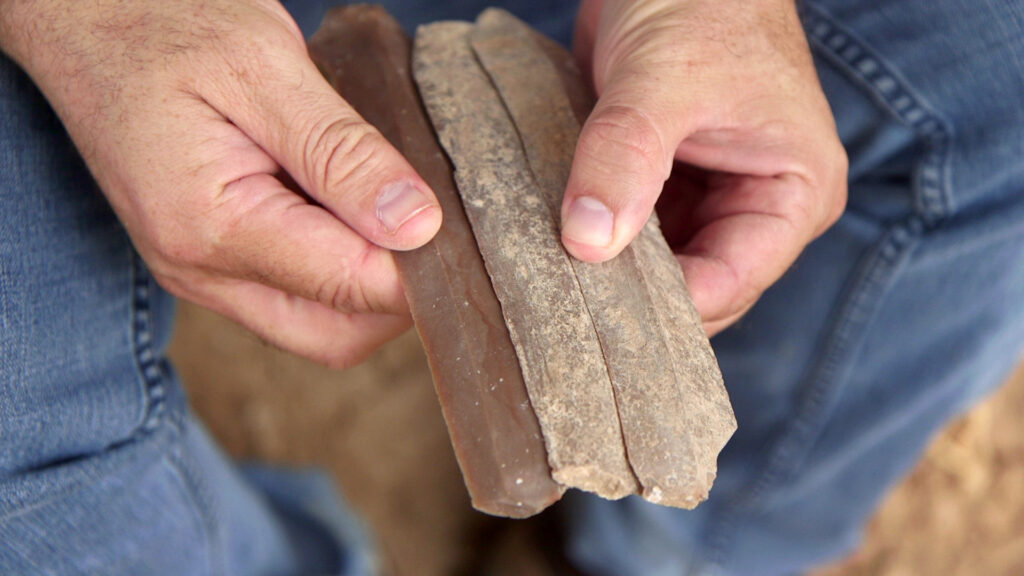
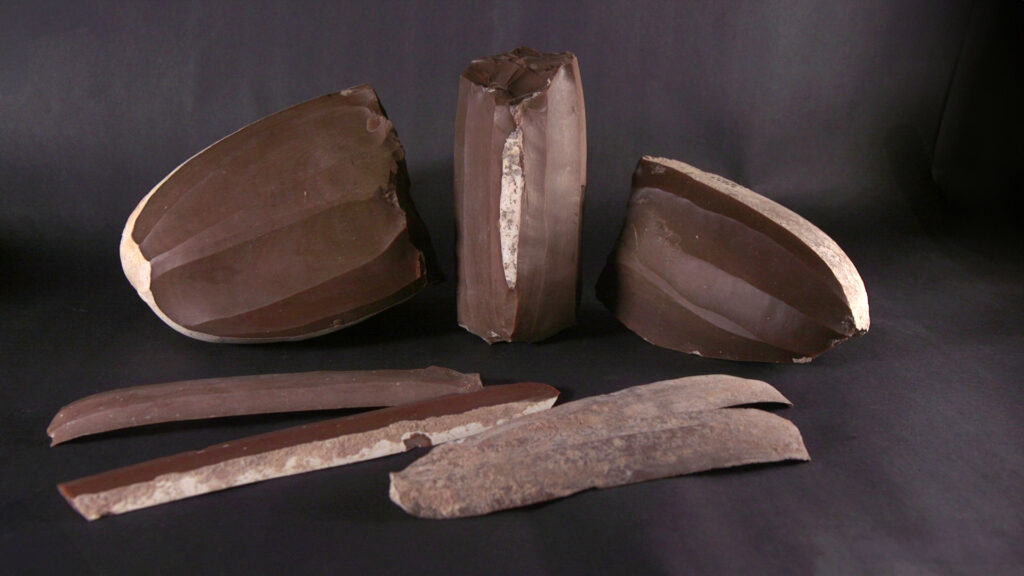
The flint blades created in the ancient workshop.Photography: Emil Aladjem, Israel Antiquities Authority.
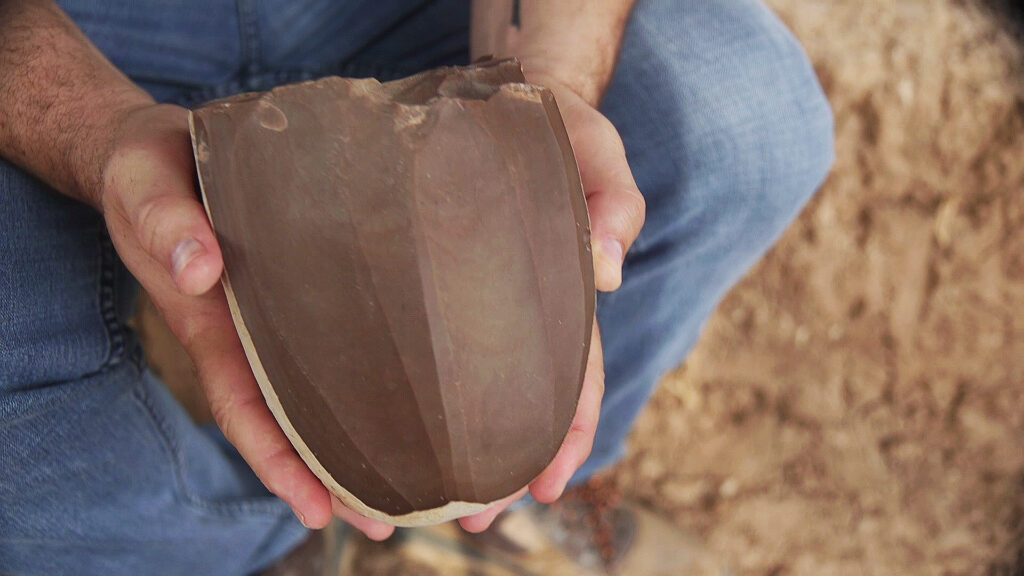
A flint core from which the blades were produced about 5,500 years ago -a rare excavation find.
The most impressive findings include large flint cores from which extremely sharp, uniformly shaped blades were produced. These tools served multiple purposes: as knives for cutting and butchering, and as harvesting implements, including sickle blades. The production technology was remarkably sophisticated, incorporating the use of a crane-like device to exert precise pressure on the flint – a technique that demonstrates advanced understanding of materials and engineering principles.

The Israel Antiquities Authority excavation near Kiryat Gat.
The significance of this ancient blade workshop takes on additional resonance when considered alongside biblical accounts of weapon scarcity in ancient Israel. The First Book of Samuel records a telling detail about the technological disadvantage faced by the Israelites during the reign of King Saul: “On the day of the battle not a sword or spear was to be found in the hands of any of the people with Saul and Jonathan; only Saul and his son Jonathan had them” (1 Samuel 13:22).
This biblical passage highlights the Philistine monopoly on iron technology during the early Iron Age, roughly 3,000 years ago. The Philistines, who controlled metalworking techniques, deliberately prevented the Israelites from accessing blacksmiths who could forge or repair metal weapons. In contrast, the newly discovered Canaanite blade workshop from 5,500 years ago demonstrates that long before metal weapons became available, ancient peoples in this region had developed sophisticated alternatives using flint technology.
The juxtaposition is striking: while the Israelites of Saul’s time were forced to rely on agricultural tools and makeshift weapons due to Philistine technological control, their ancestors had mastered an advanced stone tool industry that produced razor-sharp blades through highly specialized techniques.
The location of this discovery carries profound biblical significance. Kiryat Gat, the modern city near the excavation site, was mistakenly named for Gath, one of the five major cities of the Philistines. Gath was one of the five cities of the Philistine pentapolis during the Iron Age, located in northeastern Philistia, close to the border with Judah.
The biblical city of Gath holds legendary status as the hometown of Goliath, who came from Gath to battle David (1 Samuel 17:4). The city also features prominently in the account of David’s flight from King Saul, when David fled to Achish, king of Gath, and feigned madness at the city’s gate (1 Samuel 21:11-16).
Recent archaeological work in the region has continued to shed light on biblical history. The biblical town of Ziklag, noted in the Books of Joshua and Samuel as a Philistine town near the city of Gath, may have been identified through radiocarbon dating, which suggests a settlement dating back to the early 10th century B.C.E., a period associated with King David.
Additionally, a fortress from the biblical period of the Judges was found near Kiryat Gat, built approximately 3,200 years ago as a Canaanite attempt to defend against the rising Philistines who arrived in the area. This discovery provides archaeological evidence for the tumultuous period described in the Book of Judges, when various peoples vied for control of the strategic coastal plain.
The flint workshop was part of a much larger and more complex settlement than previously understood. The excavation directors report that “the archaeological site we excavated was used as an active settlement continuously for hundreds of years – from the Chalcolithic period through to the Early Bronze Age.” The settlement covered an impressive area of over half a kilometer and included hundreds of underground pits, some of which were lined with mud bricks.
These subterranean facilities served diverse functions, including storage spaces for agricultural surpluses, dwelling places for inhabitants, workshops for various crafts, and locations for cultic and social rituals. This multifaceted use of space indicates a sophisticated understanding of urban planning and resource management that predates many of the great civilizations of antiquity.
One of the most intriguing aspects of the discovery relates to what archaeologists didn’t find at the site. Dr. Vardi notes, “This is a sophisticated industry – not only because of the tools themselves, but also because of what is not found. The waste fragments, the debitage, were not scattered outside the site – perhaps to better protect and preserve the professional knowledge within the group of experts.”
This careful management of production waste suggests that the craftsmen were deliberately protecting their trade secrets, maintaining a monopoly on the specialized knowledge required to produce these high-quality blades. Such professional secrecy indicates a level of economic sophistication that rivals modern industrial practices.
The workshop served as a regional distribution center, with archaeologists concluding that “this site served as a center, from which Canaanite blades were distributed across broad regions in the Levant.” This extensive trade network demonstrates that, even 5,500 years ago, the inhabitants of this region were connected to broader economic systems that spanned the ancient Near East.
The Canaanite blades represent a pinnacle of stone tool technology, developed during a transitional period when humans were beginning to experiment with metals but still relied primarily on traditional materials. In the Early Bronze Age, people used tools made from natural raw materials: flint, bone, stone, and ceramics. However, the sophisticated production techniques evidenced at this workshop suggest that stone tool technology reached heights of refinement that the advent of metalworking would soon supersede.
The precision required to produce uniform, sharp blades from flint cores using pressure-flaking techniques represents thousands of years of accumulated knowledge and skill development. The use of mechanical aids, such as the crane-like pressure device, shows that ancient craftsmen were not limited to simple hand tools but developed complex apparatus to achieve their technological goals.
This discovery significantly advances scholarly understanding of social organization in the Early Bronze Age Levant. The existence of specialized workshops, professional secrecy, and extensive trade networks all indicate that these societies were far more complex and sophisticated than previously recognized.
The excavation directors emphasize that “the discovery of a sophisticated workshop indicates a society with a complex social and economic structure already at the beginning of the Early Bronze Age. This is an important find in that it deepens the understanding of both the beginnings of urbanization and of professional specialization in the Land of Israel – phenomena that led to the establishment of large settlements and that catalyzed the creation of new social structures.”
These remarkable findings are now being presented to the public for the first time at the Jay and Jeanie Schottenstein National Campus for the Archaeology of Israel in Jerusalem. Visitors can observe both the finished blades and the rare flint cores from which they were produced, providing a tangible connection to the skilled craftsmen who worked at this site millennia ago.
The discovery represents more than just ancient technology; it offers insights into human innovation, economic organization, and social complexity that resonate across the centuries. From the sophisticated flint workshops of the Early Bronze Age to the metal weapon monopolies of the Iron Age described in biblical accounts, the region around ancient Gath continues to yield treasures that illuminate the long arc of human technological and social development.
As archaeological work continues in this historically rich region, each discovery adds new chapters to the story of human civilization in the Land of Israel, bridging the gap between biblical narrative and archaeological evidence and revealing the remarkable ingenuity of our ancient predecessors.




